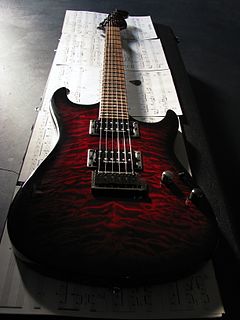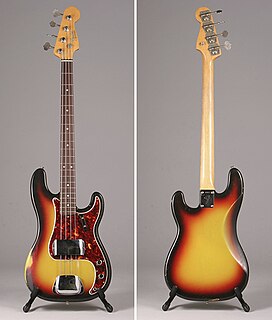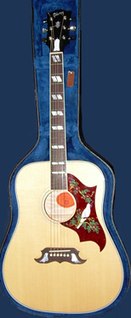Construction
Unlike a traditional guitar pickup that uses a plastic or fiber bobbin as a form for winding its coil, the lipstick-tube pickup has its coil wrapped around an alnico VI bar magnet, and then wrapped in tape, usually a cellophane-type tape on vintage units, before being inserted into the metal tube casing. Most vintage Danelectro guitars had their pickups mounted using spring-loaded brackets underneath the tube casing, which could be adjusted for height by means of screws located on the back of the guitar body. Other Danelectro guitars, like the Coral hollowbody series, suspended the pickups from the guitar's top with two screws threaded through the guitar's top and into the brackets. Modern lipstick-tube pickups are usually mounted in a pickguard.
Vintage Danelectro lipstick-tube pickups are quite wide, at 3.22 in (8.18 cm) overall. They cannot be retrofitted into a Stratocaster or similar guitar without removing plastic from the pickguard and wood from the guitar body. To overcome this situation, a variety of aftermarket lipstick-tube pickups have been offered that are the same general width as the common Stratocaster style single-coils, with a 2.77 in (7.04 cm) wide tube casing. [1] More recently, Fender themselves introduced a Stratocaster with Seymour Duncan designed lipstick-tube pickups for their Squier line, called the Surf Stratocaster and a Fender factory special run (FSR) American Standard Stratocaster with Seymour Duncan SLS-1 lipstick pickups, as well as offering the same SLS-1 pickups as a Custom Shop option.

A humbucking pickup, humbucker, or double coil, is a type of guitar pickup that uses two coils to cancel out the interference picked up by coil pickups caused by electromagnetic interference, particularly mains hum. Most pickups use magnets to produce a magnetic field around the strings, and induce an electrical current in the surrounding coils as the strings vibrate. Humbuckers work by pairing a coil that has the north poles of its magnets oriented "up" with another coil right next to it with the south pole of its magnets oriented up. By connecting the coils together out of phase, the interference is significantly reduced via phase cancellation: the string signals from both coils add up instead of canceling, because the magnets are placed in opposite polarity. The coils can be connected in series or in parallel in order to achieve this hum-cancellation effect, although it is much more common for the coils of a humbucker pickup to be connected in series. In addition to electric guitar pickups, humbucking coils are sometimes used in dynamic microphones to cancel electromagnetic hum.

A single coil pickup is a type of magnetic transducer, or pickup, for the electric guitar and the electric bass. It electromagnetically converts the vibration of the strings to an electric signal. Single coil pickups are one of the two most popular designs, along with dual-coil or "humbucking" pickups.
The Fender Jazzmaster is an electric guitar designed as a more expensive sibling of the Fender Stratocaster. First introduced at the 1958 NAMM Show, it was initially marketed to jazz guitarists, but found favor among surf rock guitarists in the early 1960s. Its appearance is similar to the Jaguar, though it is tonally and physically different in many technical ways, including pickup design, scale length and controls.

The Fender Showmaster is a discontinued model of electric guitar made by Fender, and is characteristic of a superstrat. Also see the badge change of Stagemaster due to legal reasons.
The Fender Jaguar is an electric guitar by Fender Musical Instruments characterized by an offset-waist body, a relatively unusual switching system with two separate circuits for lead and rhythm, and a short-scale 24" neck. Owing some roots to the Jazzmaster, it was introduced in 1962 as Fender's feature-laden top-of-the-line model, designed to lure players from Gibson. During its initial 13-year production run, the Jaguar did not sell as well as the less expensive Stratocaster and Telecaster, and achieved its most noticeable popularity in the surf music scene. After the Jaguar was taken out of production in 1975, vintage Jaguars became popular first with American punk rock players, and then more so during the alternative rock, shoegazing and indie rock movements of the 1980s and 1990s. Fender began making a version in Japan in the mid-1980s, and then introduced a USA-made reissue in 1999. Since then, Fender has made a variety of Jaguars in America, Mexico, Indonesia and China under both the Fender and Squier labels. Original vintage Jaguars sell for many times their original price.

The Fender Precision Bass is a model of electric bass manufactured by Fender Musical Instruments Corporation. In its standard, post-1957 configuration, the Precision Bass is a solid body, four-stringed instrument equipped with a single split-coil humbucking pickup and a one-piece, 20-fret maple neck with rosewood or maple fingerboard.

The Fender Cyclone denotes a series of electric guitars made by Fender. Introduced in late 1997, the Cyclone body is similarly styled to the Mustang, but it is a quarter of an inch thicker than the body of a Mustang and is made of poplar, whereas contemporary Mustang reissues were made of basswood.

The Fender Telecaster Deluxe is a solid-body electric guitar originally produced from 1972 to 1981, and re-issued by Fender multiple times starting in 2004.

A pickguard is a piece of plastic or other material that is placed on the body of a guitar, mandolin or similar plucked string instrument. The main purpose of the pickguard is to protect the guitar's finish from being scratched by the guitar pick.
The Fender Lead Series was produced by the Fender/Rogers/Rhodes Division of CBS Musical Instruments. The series comprised Lead I, Lead II, Lead III and Lead Bass models.

The Squier '51 is an electric guitar made by Squier, a subsidiary of Fender. The '51 is notable for being one of the few original designs made by Squier, which normally manufactures less expensive authorized copies of Fender's popular guitars and bass guitars.
The Fender Telecaster Bass is an electric bass introduced in 1968 by Fender Musical Instruments Corporation. With few physical changes through the 1970s, it was discontinued in 1979 and reissued in 2007 by Fender's subsidiary Squier as the Squier Vintage Modified Precision Bass TB, which was discontinued in 2014.
The Fender Bullet was an electric guitar originally designed by John Page and manufactured and marketed by the Fender Musical Instruments Corporation. It was first introduced as a line of "student" guitars to replace the outgoing Mustang and Musicmaster models.
Fender California Series electric guitars were produced by Fender in 1997 and 1998. The guitars were carved in California, shipped to Baja California Norte, Ensenada, Mexico for painting, then assembled in California.
The Fender Noiseless series is a line of electric guitar pickups made by the Fender Musical Instruments Corporation. Introduced in 1998, they feature a row of six dual stacked-coil pole pieces, designed to cancel hum noise. This single coil sized stack consists of a row of paired single coils stacked one on top of the other, compacted so as to fit (incognito) into the same size width space as a regular single coil pickup. This is to be contrasted with the original humbucking pickup design, which is a row of paired single coils double wide.
The Jeff Beck Stratocaster is an electric solid body guitar made by Fender Musical Instruments for British guitarist Jeff Beck. This Artist Signature guitar was introduced in 1991 and upgraded ten years later. The Custom Shop version, introduced in 2004, is available in Olympic White and Surf Green finishes.
The Danelectro C model guitars were the first instruments designed by Danelectro, coming in both single and dual pickup versions. Designed by 1953, they were put into production and retailed from 1954 to 1955 until being replaced by the Danelectro U model in 1956.
The Fender Telecaster, colloquially known as the Tele, is the world's first mass-produced, commercially successful solid-body electric guitar. Its simple yet effective design and revolutionary sound broke ground and set trends in electric guitar manufacturing and popular music. Introduced for national distribution as the Broadcaster in the autumn of 1950 as a two-pickup version of its sister model, the single-pickup Esquire, the pair were the first guitars of their kind manufactured on a substantial scale. A trademark conflict with a rival manufacturer's led to the guitar being renamed in 1951. Initially, the Broadcaster name was simply cut off of the labels placed on the guitars and later in 1951, the final name of Telecaster was applied to the guitar to take advantage of the advent of television. The Telecaster quickly became a popular model, and has remained in continuous production since its first incarnation.

David Michael Murray is an English guitarist and songwriter, best known as a member of the British heavy metal band Iron Maiden since 1976. He joined Iron Maiden early in its history, and is the second-longest serving member of the band after founder Steve Harris. Murray and Harris are the only members of Iron Maiden to have appeared on all of the band's releases.

The Fender Cabronita Telecaster is a class of guitars built by Fender Musical Instruments Corporation based on their Telecaster body shape. The name Cabronita is Spanish slang and roughly translates as little bastard or little devil. While retaining the shape and general feel of a Telecaster, they are a radical departure from the traditional electronics and sounds associated with the instrument. Like virtually all Telecaster submodels, they are labeled simply as a Fender Telecaster on the headstock logo, identifiable only by their features.










